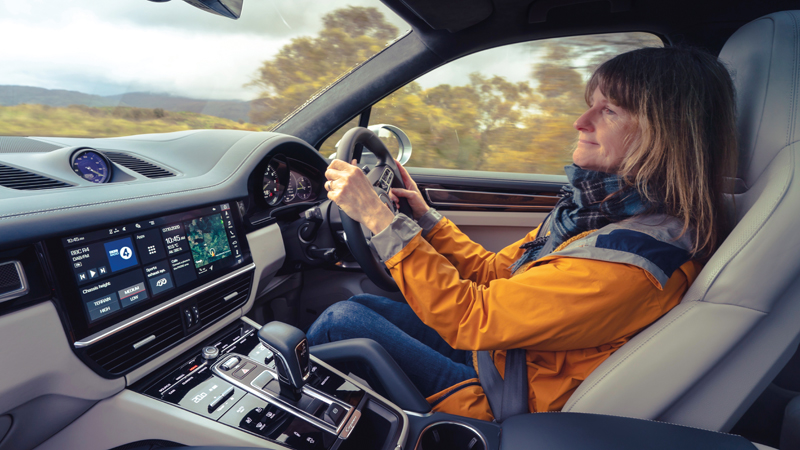For more than 20 years, Professor Lynn Pierce has been studying the state of the driver at the time of driving. The author's research, which often becomes a sensation and gets on the main pages of publications, is built around a seemingly simple question: what do we think about when we are driving?

The pleasant sound of a Cayenne door slamming shut. Lynn Pierce exhales slowly. For decades now, the modern car has been something of a refuge for the professor: a place to play music, meditate and solve problems, a place where you can feel safe and find inspiration. Today, Lynn spent the morning working on lectures to students at Lancaster University, where she has been a professor of literary and cultural theory for 30 years, in the Department of English Literature and Creative Writing. In her head - a hurricane of thoughts. Or is it already gone?
“Whenever I get into the car, I feel incredibly relieved. Lynn Pierce
“Whenever I get into the car, I feel incredibly relieved. My body relaxes – I always look forward to the moment when I can finally think,” says Pierce, starting the trip and slowly driving down the steep road from his Victorian country house.
Special connection with the car

Born in Cornwall to a mechanic's family, Lynn grew up surrounded by machines. For the past 22 years, the professor has been living in the north-west of Scotland: during this time, she made more than one 800-mile race towards her parents' house, after which she returned back to her place - in a small town located two hours north of Glasgow.
Pierce published her first essay on motorsport in 2000 under the title "Driving North/Driving South". It was followed by the essay Drivetime: Literary Excursions in Automotive Consciousness, which was described by industry experts as an outstanding work. In it, Lynn notes that long road trips give her “the love and need to drive, which in turn offers valuable, truly exceptional space for reflection. Nothing can interfere with this cherished occupation, fenced off from the rest of the world and not subject to time. “Many of the questions that occupied me, which concerned both my professional and personal life, were unraveled in the course of moving by car.” It was these feelings and a special connection with the car that prompted Lynn to delve deeper into the study of the psychological aspects of the driver's condition.
After driving hard on winding, narrow roads, Pierce turns onto the A82, a route she considers a "lifeline" for quiet Scottish communities and her favorite road in the UK. By turning on the electric mode of the car, Lynn easily overcomes kilometers of road, surrounded by magnificent Scottish landscapes on both sides.
The Key to Productive Thinking
“When I was working on my book and sharing with others my interest in the thought process of a person behind the wheel, I was often treated with distrust. Indeed, some people have a certain delusion - they think that the only thing we can concentrate on while driving is driving. However, psychologists who have long been interested in the issue are sure that driving a car - in addition to being one of the most difficult everyday tasks - also “releases” some brain resources that help us think productively,” explains the professor.
“Today, it is fairly widely believed that the reason we can drift into dreams, process thoughts, or even carry on a conversation while driving a car is because the central executive organ of the brain is constantly vigilant. So, it instantly returns our attention to the road when and where it becomes necessary. That’s why it’s much harder for us to think about abstract things in bad weather, at night, or while driving a new car.”
After spending as much time meditating on literature and journalistic texts as she did on the English highway, Peirce was able to analyze the wide range of cognitive and emotional states that a person experiences while driving.
"Time out" for problem solving
“By studying the euphoria that comes from driving at high speeds, active thought processes, and the emotions of connection with the natural world that occur on a scenic road, I found that different types of driving activate different types of thinking in the human brain,” says Lynn Pier.
“Personally, for me, this topic was most clearly revealed in American literature, in particular, in Joan Didion's novel “Play It Like It's Written”, which tells how driving on the freeways of Los Angeles can help a person suffering from mental anguish. By activating a certain part of the brain, driving helps us calm down and analyze problems more balanced. That's why for many of us, including myself, driving a car is a kind of "time out" for their decision."
In addition to serving in the English Department at Lancaster University, Pierce is Director of Humanities at CeMoRe, the Center for Mobility Research, which has been involved in automation and sustainability research since 2003. Electric and hybrid vehicles are of particular interest to the Center.

The joy of slowing down
“In my opinion, fast driving, no matter how exhilarating it is, is not so much fun as a person gets when driving at low speed. One of the most amazing opportunities that the car gives us is the exploration of the beauty of nature and the landscapes around us.”
I like to use secondary roads - slow driving allows me to admire the nature of my native land. The unique feeling of driving in quiet electric mode really enhances this experience - no wonder that the first users of electric vehicles in the early 20th century admired precisely this silence.

For me, sustainable road transport is not only about the pursuit of a carbon-free future. One of the most important principles is to give the car more value, so that it serves a person longer. Superbly designed cars like Porsche are built to last – I like to think that every new car has a long “life” ahead of it.
Returning to the deserted one-lane road, Pierce opens the window and brings the Cayenne to a gentle stop. A few feet away, a Scottish Highland cow raises its head and looks directly into its eyes. The professor smiles.
Here they are - peace and complete harmony.


 DOWNLOAD
DOWNLOAD LOOK
LOOK
 Top Content of the Month
Top Content of the Month


